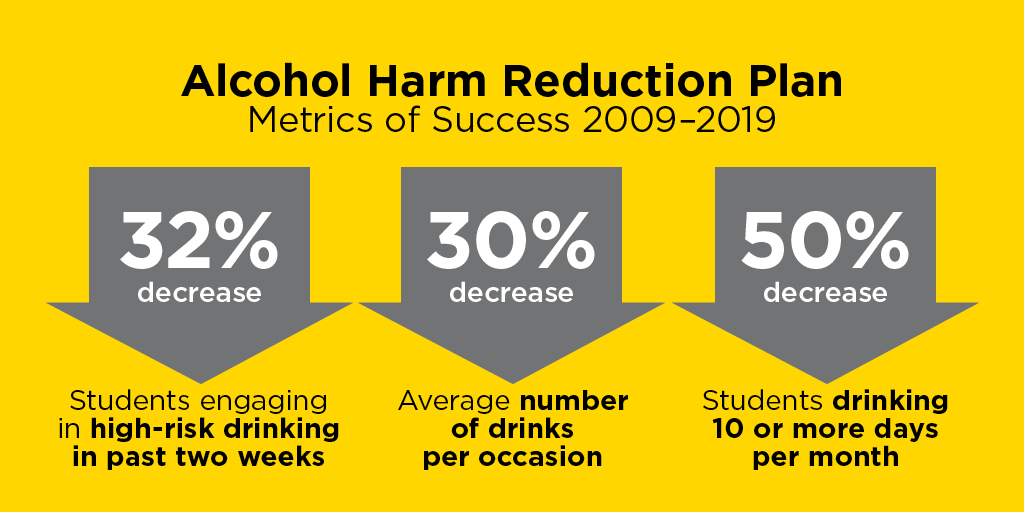High-risk undergraduate drinking has decreased significantly at the University of Iowa due to its 10-year commitment to alcohol harm reduction.
Learn more
Read the 2019–2022 Alcohol Harm Reduction Plan.
Read about the Partnership for Alcohol Safety.
View the National College Health Assessment Summary of the University of Iowa results from spring of 2019.
According to new data from the National College Health Assessment (NCHA) survey, high-risk drinking at the UI has decreased 32%, the number of undergraduates drinking 10 or more days a month has decreased by nearly 50%, and undergraduates now consume an average of two fewer drinks per occasion compared to data from 2009. This year, the UI also began tracking key metrics for graduate students, which can be viewed in the National College Health Assessment Summary for the University of Iowa.
“The Alcohol Harm Reduction Advisory Committee has worked hard over the last 10 years to build a culture that is focused on student well-being and safety,” says Melissa Shivers, vice president for student life. “Though there’s still work to do in order to achieve our goals, we’re encouraged by our progress and remain committed to decreasing high-risk drinking and the related harmful consequences.”

UI Student Wellness conducts NCHA surveys annually to collect anonymous data on undergraduate and graduate health practices, behaviors, and perceptions. The NCHA survey measures high-risk drinking as consuming five or more drinks on one occasion in the last two weeks.
Short-term reduction
According to the UI’s spring 2019 survey:
- 47.7% of undergraduates reported engaging in high-risk drinking in the previous two weeks, which is a slight decrease from 49.6% in 2018.
- The average number of drinks consumed per occasion is reported at 5.21, which is stable with 5.29 in 2018.
- Undergraduates who used alcohol 10 or more days in the last 30 days decreased from 22.7 in 2018 to 18.1% in 2019.
Long-term progress
The UI has made significant progress in curtailing high-risk undergraduate drinking and its negative effects since forming the UI Alcohol Harm Reduction Advisory Committee in 2009.
However, the 2019 NCHA data show UI undergraduates drink more and experience more negative consequences from consuming alcohol than the national average.
The recently published 2019–2022 Alcohol Harm Reduction Plan outlines a comprehensive list of evidence-based strategies to continue addressing high-risk drinking and its negative effects. The plan also addresses survey data that show high rates of marijuana and other illicit drug use, compared to college students nationwide. The UI is one of the only Big Ten universities that has developed a detailed plan, measures the outcomes of strategies, and reports publicly on progress and efforts.
The Alcohol Harm Reduction (AHR) Advisory Committee, a broad-based group of faculty, staff, and students from across campus, helped develop the plan which used 2018 NCHA data to inform its recommendations since 2019 data wasn’t available yet.
According to undergraduate data, the UI marijuana use (30-day prevalence) rate is consistently higher than the national average and this year is at 30.1% compared to 22.4% nationally. Of high-risk drinkers, 46.8% have used marijuana in the last 30 days, more than triple the rate for students who choose not to drink or who drink in low-risk ways. The use of marijuana with alcohol is a key metric that will be used to assess progress moving forward.
“This marks the tenth year of our community’s dedication, transparency, and strategic commitment to reducing high-risk drinking on campus,” says Tanya Villhauer, UI director for student wellness and harm reduction initiatives. “We’re pleased we continue to make incremental progress on curbing high-risk drinking and drug use, and we will continue to advance our efforts to help bring us closer to the national average through the 2019–2022 Alcohol Harm Reduction Plan.”
You can make a difference
Talking with your student lowers the risk that they will experience serious alcohol-related consequences. Listen to your student and offer reassurance that you trust them and are initiating the conversation to help them because you care. Respect their privacy and desire to be independent while trying to appeal to common goals. Keep these conversations going after they arrive on campus.
There are several topics you should address, including:
- More UI students are choosing to delay drinking or not to drink. Student perceptions are out of line with data.
- Do not provide messages that normalize drinking in college as a rite of passage.
- Reasons for not drinking and the many negative effects that can result from drinking.
- How drinking affects the body. Students need to know how drinking on a given occasion will affect them.
- Your own position concerning your student’s drinking. Make clear exactly what is OK and what is not.
- Students drink for a variety of reasons. Your student will be better able to think through the choices they make when confronted with “positive” motivations if you address this directly.
- Your willingness to help. Make clear you are willing to help find constructive alternatives.